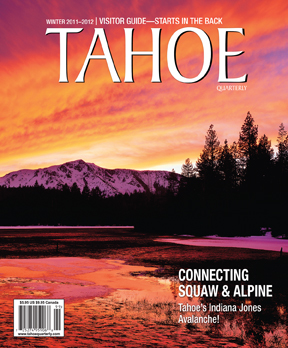Bringing About Better Boating Safety

In addition to search and rescue operations, the U.S. Coast Guard, based in Tahoe City, provides education about and compliance with boating safety laws.
Thirty years ago, a Lake Tahoe boating fatality stunned the West Shore’s tight-knit community so much so that the tragic details remain vividly alive in old-timers’ memories—and serve as a stiff reminder of the dangers of irresponsible watercraft operation.
“It’s a horrible story,” says Bev Bedard, who was the director of the North Lake Tahoe Chamber of Commerce at the time. “Bobby Everson was like the town’s son.” Everson had worked in marketing at Homewood and Alpine Meadows ski resorts, and came up with the idea of holding a winter festival to keep skiers on the slopes later in the season. The first SnowFest! was held in 1982, in memory of Everson. Changes in boating safety took longer to accomplish.
After viewing Tahoe City’s Fourth of July fireworks by boat in 1981, Everson and his girlfriend moored their sailboat in a buoy field south of Sunnyside for the night. “Sometime after midnight, a powerful boat full of college kids came up over the back end of Bobby’s boat and cut it in half,” Bedard says. Everson was killed instantly and his girlfriend suffered disabling brain damage.
The U.S. Coast Guard was called to the scene. “The boat was in bad enough shape that they couldn’t see anyone initially. The girl was below in the cabin unconscious and lying in water. Everson was already dead,” says Scott Baumgardner, who retired from the Placer County Sheriff’s Office in 2004 after 22 years as a boating safety officer. The Coast Guard pursued the hit-and-run suspects and, unable to find them, returned to the scene, discovering Everson and his girlfriend in the wreckage.
Those involved in causing the collision were eventually found and investigated for hit-and-run and manslaughter, but the case didn’t make it past a preliminary hearing, says Baumgardner. There were no blood tests to prove drunkenness, nor could the actual boat operator be identified. There was a technicality of whether or not the moored sailboat was required to have white lights around the entire boat. Baumgardner was one of the divers who found proof on The Lake’s bottom that the red and green navigation light was used.
“Their defense said that they came about and went back to Everson’s boat, saw a collision but didn’t see any people,” Baumgardner said, adding that their case was strengthened because the Coast Guard had done the same thing.
Since then, boating laws have been amended to help law enforcement prosecute accidents such as Everson’s. A person involved in a boating accident can now be charged with vessel manslaughter, which requires a lesser degree of negligence for conviction. Statutes regarding drinking and driving a boat are stiffer, too, affecting a person’s driving record. Boating law enforcement can also now hand suspected drunk drivers over to the California Highway Patrol to be taken for blood alcohol content testing, Baumgardner says.
Operation Dry Water, launched in 2009 in Nevada, is a concerted effort each summer to catch those boating under the influence. “Getting drunken boaters off the water is one of our top boating safety priorities,” says David Pfiffner, Nevada’s boating law administrator.
Boating education has increased as well. “As far as boating safety goes, the biggest concern is ignorance,” says Jerry Gilmore, public education officer for the North Lake Tahoe Coast Guard Auxiliary. Nevada now requires anyone born after January 1, 1983, to complete a boating safety course in order to operate a watercraft on Lake Tahoe. In California, boaters are encouraged, but not required, to take an online boating safety course. The North Lake Tahoe Coast Guard Auxiliary also offers classroom courses, which include tips for safety on Lake Tahoe.
Boating safety education and law enforcement have made great strides since Everson’s accident in 1981; however, the danger of boating is not minimized. “Boating is not driving your car, especially at night; it’s a lot more respon- sibility,” Baumgardner says. Boaters driving fast cannot see what’s ahead in the dark—be it a log or another boat. During his 22 years of patrolling Placer County’s 43 percent of Lake Tahoe’s 193 square miles of water, Baumgardner says he worked to educate boaters about safety, operating rules and suggested equipment, but also to enforce safe speeds (“I gave a number of speeding tickets over the years because people were going lickety-split,” he says) and issue citations for noise violations and drunken boating. Baumgardner’s suggestions for safe boating on Lake Tahoe: Take a boating safety course, make sure you have the right equipment and life jackets on board, and slow down. By Tanya Canino. TQ






